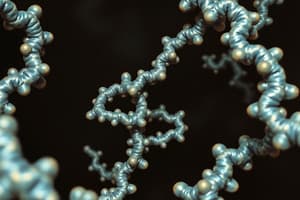Podcast
Questions and Answers
What is the primary structural feature that differentiates amino acids from one another?
What is the primary structural feature that differentiates amino acids from one another?
- The R group (correct)
- The carboxyl group
- The amino group
- The α carbon
Which of the following statements about amino acids is true?
Which of the following statements about amino acids is true?
- All amino acids contain two chiral carbon atoms.
- Glycine is the most complex amino acid.
- Amino acids have no functional groups.
- L-amino acids are the only type manufactured in cells. (correct)
What type of bond links amino acids together in proteins?
What type of bond links amino acids together in proteins?
- Hydrogen bond
- Ionic bond
- Peptide bond (correct)
- Covalent bond
How many amino acids does a tripeptide consist of?
How many amino acids does a tripeptide consist of?
What is the correct classification of a protein that contains 75 amino acids?
What is the correct classification of a protein that contains 75 amino acids?
Which amino acid is optically inactive due to its structure?
Which amino acid is optically inactive due to its structure?
What is the range of amino acids typically found in proteins?
What is the range of amino acids typically found in proteins?
What does the term 'α' in alpha-amino acid refer to?
What does the term 'α' in alpha-amino acid refer to?
Which of the following amino acids is considered essential?
Which of the following amino acids is considered essential?
What characterizes non-essential amino acids?
What characterizes non-essential amino acids?
Which amino acid is achiral?
Which amino acid is achiral?
Which group of amino acids does not form hydrogen bonds with water?
Which group of amino acids does not form hydrogen bonds with water?
What is a characteristic of polar neutral amino acids?
What is a characteristic of polar neutral amino acids?
Which of the following is true about L-alpha alanine and L-alpha valine?
Which of the following is true about L-alpha alanine and L-alpha valine?
Which amino acid has the polar hydrophilic group -OH?
Which amino acid has the polar hydrophilic group -OH?
What distinguishes the properties of polar neutral amino acids from non-polar amino acids?
What distinguishes the properties of polar neutral amino acids from non-polar amino acids?
Which of the following amino acids is classified as a polar, positively charged amino acid?
Which of the following amino acids is classified as a polar, positively charged amino acid?
Which of these amino acids is considered an acidic, polar, negatively charged amino acid?
Which of these amino acids is considered an acidic, polar, negatively charged amino acid?
What type of interaction is mainly exhibited by hydrophobic amino acids like alanine and valine?
What type of interaction is mainly exhibited by hydrophobic amino acids like alanine and valine?
Which of the following amino acids cannot be synthesized in the body and is therefore essential for nutrition?
Which of the following amino acids cannot be synthesized in the body and is therefore essential for nutrition?
Which amino acid is characterized by a cyclical amino group and is often found at the beginning of proteins?
Which amino acid is characterized by a cyclical amino group and is often found at the beginning of proteins?
What is the metabolic precursor for cysteine?
What is the metabolic precursor for cysteine?
Which of these amino acids is not classified as a basic amino acid?
Which of these amino acids is not classified as a basic amino acid?
Which interaction occurs when an ionic bond is formed between a basic amino acid and an acidic amino acid?
Which interaction occurs when an ionic bond is formed between a basic amino acid and an acidic amino acid?
What type of bond is formed when two cysteine molecules are oxidized?
What type of bond is formed when two cysteine molecules are oxidized?
Which amino acids are categorized as aromatic?
Which amino acids are categorized as aromatic?
At physiological pH, which form do amino acids predominantly take?
At physiological pH, which form do amino acids predominantly take?
What is the result of a peptide bond formation?
What is the result of a peptide bond formation?
What happens to the carboxylic group of amino acids at a lower pH?
What happens to the carboxylic group of amino acids at a lower pH?
Which charge do amino acids have at their isoelectric point (pI)?
Which charge do amino acids have at their isoelectric point (pI)?
In electrophoresis, what direction do positively charged amino acids move?
In electrophoresis, what direction do positively charged amino acids move?
Which interaction is characterized as a weak attractive force between aromatic rings?
Which interaction is characterized as a weak attractive force between aromatic rings?
Flashcards are hidden until you start studying
Study Notes
What are Proteins?
- Large molecules composed of long chains of amino acids.
- Proteins play key roles in various body functions and processes.
- Name originates from the Greek word "Proteios," meaning "holding first place."
Structure of Proteins
- Proteins are chains of amino acids, classified by their length:
- Peptides: fewer than 50 amino acids
- Dipeptides: 2 amino acids
- Tripeptides: 3 amino acids
- Polypeptides: more than 10 amino acids
- Proteins: more than 50 amino acids, commonly 100 to 10,000.
Amino Acids
- Comprised of carbon, hydrogen, oxygen, and nitrogen; contain an amino group (-NH2) and a carboxyl group (-COOH).
- All amino acids, except glycine, have at least one chiral carbon and exhibit optical activity.
- Only L-amino acids are incorporated into proteins; essential for various biological functions.
Classification of Amino Acids
- Essential Amino Acids: Cannot be produced by the body and must be obtained through diet (e.g., lysine, arginine, histidine).
- Non-Essential Amino Acids: Synthesized by the body (e.g., alanine, asparagine, glutamic acid).
Polar and Non-Polar Amino Acids
- Non-Polar Amino Acids: Hydrophobic, unable to hydrogen bond with water (e.g., alanine, valine, phenylalanine).
- Polar Neutral Amino Acids: Contain polar groups capable of forming hydrogen bonds (e.g., serine, threonine).
- Polar, Positively Charged Amino Acids: Basic amino acids with positively charged side chains (e.g., lysine, arginine).
- Polar, Negatively Charged Amino Acids: Acidic with negatively charged side chains (e.g., aspartic acid, glutamic acid).
Optical Activity of Amino Acids
- Glycine is the only optically inactive amino acid due to the presence of two hydrogen atoms on its asymmetric carbon.
- L-α Alanine and L-α Valine are optically active due to their chiral centers.
Interactions Exhibited by R-Groups
- Hydrophobic Interactions: Occur with amino acids having hydrocarbon R-groups.
- Ionic Interactions: Involve deprotonation of acidic amino acids and protonation of basic amino acids (e.g., lysine and aspartic acid).
- Hydrogen Bonding: Formed by hydroxyl or sulfhydryl-containing amino acids (e.g., serine, cysteine).
- Disulfide Bonds: Strong covalent bonds formed from the oxidation of cysteine molecules.
- Stacking Interactions: Non-covalent interactions between aromatic rings (e.g., phenylalanine, tryptophan).
Acid-Base Properties and Isoelectric Point
- Amino acids are amphoteric: can act as both acids (donors) and bases (acceptors).
- At physiological pH (7.38), carboxylic groups lose protons forming zwitterions, neutral molecules with both positive and negative charges.
- At the isoelectric point (pI), amino acids have no net charge and do not migrate during electrophoresis.
Peptide Bond
- Known as amide bond, formed through the reaction between the carboxyl group of one amino acid and the amino group of another, releasing water.
Studying That Suits You
Use AI to generate personalized quizzes and flashcards to suit your learning preferences.



